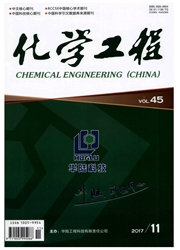

 中文摘要:
中文摘要:
水系统集成技术是把整个工业用水系统作为一个整体来看待,并考虑水质、水量的分配,从而使系统用水的重复利用率达到最大,同时废水排放量最小。甲醇企业是用水和废水排放的大户,将水系统集成技术应用于甲醇工业,具有重要意义。文中结合水系统集成技术的工业应用现状,总结了水系统集成技术在工业企业中应用的一般步骤,具体分为以下几步:选定目标系统,明确水源水阱,确定关键污染物组分和极限进出口浓度,生成初始网络和用水网络调优。并以某甲醇厂简化的用水系统为实例,采用文中所提出的一般应用步骤,对用水网络进行了优化,获得了新鲜水节水率达34.5%的节水效果。
 英文摘要:
英文摘要:
Water system integration considers how to allocate water in a water system with the water utilization processes in a plant treated as an organic whole, and thus increasing water reuse and decreasing wastewater discharge. Methanol industries consume a large amount of freshwater and discharge a large amount of wastewater. So the application of water system integration in methanol plants is very important. Combined with the present status of application of water system integration, the general steps about the application of water system integration in industries were summarized. The major steps are as follows: selecting the system, specifying water sources and water sinks, determining the key contaminants and the limiting inlet and outlet concentrations of contaminants, generating the initial network, and adjusting the water network. The application of water system integration in a methanol plant was discussed by using the steps proposed. At last, the optimal design of water utilization networks was achieved by combination of water pinch analysis and mathematical programming, and a good result of saving 34.5 % freshwater was obtained.
 同期刊论文项目
同期刊论文项目
 同项目期刊论文
同项目期刊论文
 Process-based Graphical Approach (PGA) for Simultaneous Targeting and Design of Regeneration Recycli
Process-based Graphical Approach (PGA) for Simultaneous Targeting and Design of Regeneration Recycli Establishment and solution of eight-lump kinetic model for FCC gasoline secondary reaction using par
Establishment and solution of eight-lump kinetic model for FCC gasoline secondary reaction using par Synthesis of dimethyl carbonate from urea and methanol catalyzed by the metallic compounds at atmosp
Synthesis of dimethyl carbonate from urea and methanol catalyzed by the metallic compounds at atmosp On the use of Graphical Method to Determine the Targets of Single-contaminant Regeneration Recycling
On the use of Graphical Method to Determine the Targets of Single-contaminant Regeneration Recycling Study on co-feed and co-production system based on coal and natural gas for producing DME and electr
Study on co-feed and co-production system based on coal and natural gas for producing DME and electr Analysis on the Interactions of Parameters of Single-contaminant Regeneration Recycling Water System
Analysis on the Interactions of Parameters of Single-contaminant Regeneration Recycling Water System 期刊信息
期刊信息
